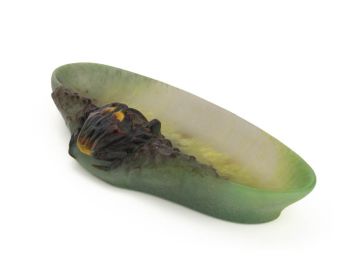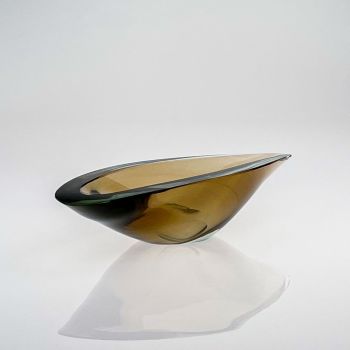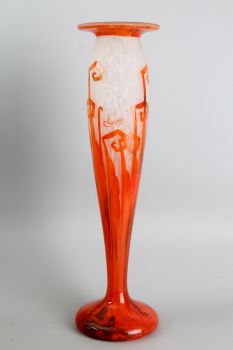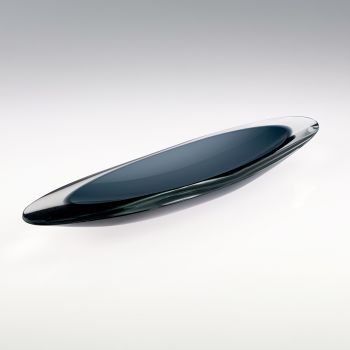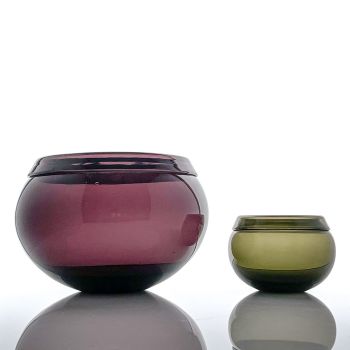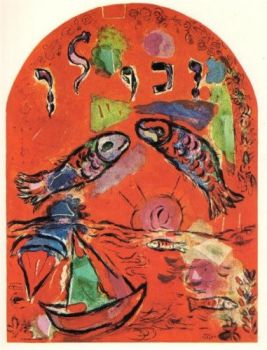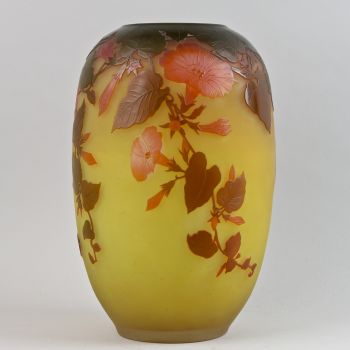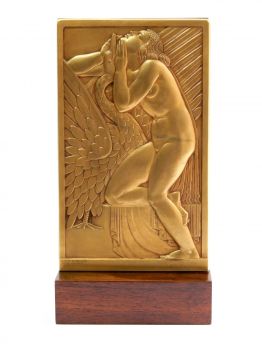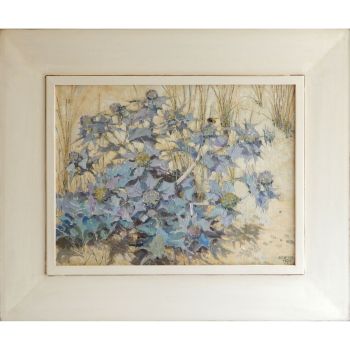Small vase 'Oléron' or 'Petits poissons' 1928 - 1932
René Lalique
Verre
9 cm
ConditionExcellent
Prix sur demande
Dille Art
- Sur l'oeuvre d'artAbout this piece
Spherical vase with numerous small fish, the vase is called 'Oléron' but is also called 'Petits poissons'.
The vase is extremely refined and beautifully made, it is executed in opalescent glass. The glass consists of multiple layers of opalescent and transparent glass on top of each other, this can be clearly seen at the neck, like the rings of a tree, you see a kind of rings that differ in colour intensity, those are the different layers of glass, (cased opalescent glass), it is a difficult technique. The vase still has very light traces of a patina, so it has had a patina. Through use and especially through cleaning the vase, the infamous annual scrub, the patina has been lost almost completely. In itself, this is not a problem at all because it was an addition to the design. Lalique originally made and sold the vase with and without patina. It just depended on the preference of the buyer. To achieve opalescent glass, a special alloy is needed, everyone had their own secret recipe. René Lalique used, in addition to the usual ingredients such as silicon dioxide or sodium, arsenic, which was banned after the war, and real gold, to increase the colour intensity. Opalescent glass has the special property that it appears bluish/white when backlit, and when light shines on the vase, the glass gets an intense golden glow, as if the sun is shining on it. Very beautiful. The first photo was taken while the vase was placed in front of the window with the sun shining outside. The rather distracting background has been removed, but nothing has been done or altered to the vase itself.
The vase is blown into the mould. It is a design by René Lalique from 1927 and has model number 1008. It was listed in the catalogue of 1928 and 1932.
The vase is signed on the underside with: 'R. Lalique, France, No. 1008'. This signature is applied with the wheel (molette). This way of signing, with the addition 'France' and the model number, was only used between 1928-1932. After 1932, the model number was omitted. According to literature, this was also only done with objects that were blown into the mould, very occasionally an object was still signed in this way if the pressed signature was not clear.
At some point, in the early 1930s, René Lalique, partly due to the crisis, decided to no longer produce designs with labour-intensive finishes. This vase was also part of that decision, and it is therefore no longer mentioned in the 1937 catalogue.
The Municipal Museum of The Hague also has an opal Oléron vase in its collection. - Sur l'artisteRené Jules Lalique (6 avril 1860, Ay, Marne - 1er mai 1945, Paris) est né le 6 avril 1860, à Ay, Marne. Il était un créateur de verre français connu pour ses créations d'art du verre, flacons de parfum, vases, bijoux, lustres, horloges et ornements de capot d'automobile. En 1872, à l'âge de douze ans, il entre au Collège Turgot où il commence à dessiner et à dessiner. Il suit les cours du soir à l'Ecole des arts décoratifs. Il y travailla de 1874 à 1876 et passa ensuite deux ans à la Crystal Palace School of Art Sydenham, Londres. Au Sydenham Art College, ses compétences en conception graphique ont été améliorées et son approche naturaliste de l'art a été développée davantage. De retour d'Angleterre, il travaille comme artiste indépendant, concevant des bijoux pour les joailliers français Cartier, Boucheron et autres. En 1885, il ouvre sa propre entreprise et conçoit et fabrique ses propres bijoux et autres pièces en verre. En 1890, Lalique est reconnu comme l'un des plus grands créateurs de bijoux Art Nouveau de France; création de pièces innovantes pour la nouvelle boutique parisienne de Samuel Bing, Maison de l'Art Nouveau. Il est devenu l'un des plus connus dans son domaine, son nom est synonyme de créativité, de beauté et de qualité. Lalique était surtout connu pour ses créations dans l'art du verre. Dans les années 1920, il se fait remarquer pour son travail dans le style Art Déco. Il était responsable des murs de verre éclairé et d'élégantes colonnes de verre colorées qui remplissaient la salle à manger et le «grand salon» du SS Normandie et les aménagements intérieurs, croix, écrans, retables et fonts de l'église Saint-Matthieu de Millbrook à Jersey ( «L'église de verre» de Lalique) Ses premières expériences à Ay ont été son influence déterminante dans ses travaux ultérieurs. En conséquence, nombre de ses bijoux et vases présentent des plantes, des fleurs et des lignes fluides. Les œuvres uniques et commerciales de René Lalique font partie des collections d'un grand nombre de musées publics à travers le monde, notamment le Museu Calouste Gulbenkian à Lisbonne, le Musée Lalique et le Musée des Arts Décoratifs en France, le Schmuckmuseum Pforzheim en Allemagne, le Victoria et Albert Museum à Londres, le Metropolitan Museum et le Corning Museum dans l'État de New York, et le Rijksmuseum à Amsterdam. René Lalique est décédé le 1er mai 1945, à Paris.
Êtes-vous intéressé par l'achat de cette oeuvre?
Artwork details
Catégorie
Sujet
Style
Matériel & technique
Couleur
Related artworks
René Lalique
Um vaso "Fougeres" verde profundo muito raro projetado por R. Lalique1912
€ 8.950Lennart Booij Fine Art and Rare Items
 Com curadoria de
Com curadoria deSilla Scheepens
1 - 4 / 12Amalric Walter
Amalric Walter & Henri Bergé – Crabe plumier1920 - 1929
Preço em pedidoAntiques Emporium
1 - 4 / 24Frères Daum
Daum Nancy – “Paysage Soleil Couchant” vase with two applied handles1900 - 1910
Preço em pedidoAntiques Emporium
Johann Loetz (Lötz) Witwe Klostermühle
Johann Loetz Witwe - Phänomen Genre 7773 – Orange1900 - 1910
Preço em pedidoAntiques Emporium
1 - 4 / 24- 1 - 4 / 24
Artista Desconhecido
Copo de beber Cristallo façon de Venise1600 - 1650
Preço em pedidoPeter Korf de Gidts - Antiquairs
1 - 4 / 24Artista Desconhecido
Japanese art deco lacquervase with Scarab beetle motif1920 - 1950
Preço em pedidoDille Art
1 - 4 / 12




























